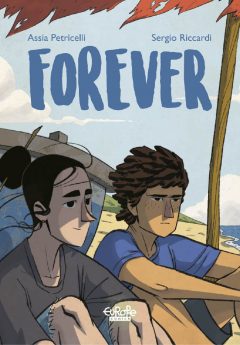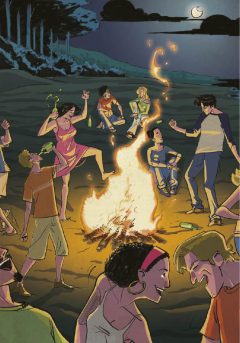Review: Forever (Europe Comics)
True love can be a tricky concept to comprehend, especially as a teenager with no experience. What constitutes love? Is it sex? Attraction? Romance? And do you need a romantic partner to be truly happy? On her summer holiday, Viola learns a lot more about love than she expected in Assia Petricelli and Sergio Ricardi’s ‘Forever’.
 Publisher: Europe Comics
Publisher: Europe Comics
Writer: Assia Petricelli
Artist: Sergio Ricardi
Price: £4.99 from Europe Comics
Viola doesn’t understand much about love. But she does understand attraction. On holiday with her mum, dad and brother, Viola is looking forward to only one thing: Fabrizio, the hottest guy in school, is also holidaying at their resort (as well as some of her school friends). Excited to develop a romantic relationship with Fabrizio, Viola is disappointed when things take a turn for the worst with her family, and Fabrizio is oblivious to her existence. Will her summer improve, or will she continue to set her sights on the wrong guy?
One of the most important messages throughout Forever that author Assia Petricelli and artist Sergio Ricardi try to convey is that you don’t need a romantic partner to be fulfilled in life. Although initially our protagonist Viola is overwhelmed by unrealistic ideas of romance, she soon learns that: ‘you can be happy with someone only when you’re capable of being happy by yourself’. Through learning to respect herself she develops a relationship with local boy Ireneo, who she finds herself drawn to. Their friendship begins with some animosity, but slowly transitions into a romantic relationship as they spend more time together. Instead of being built on unrealistic expectations of romance, their bond is formed via mutual interests, trust and respect for each other.
 In contrast, the aforementioned Fabrizio turns out to be not so nice, only becoming interested in Viola when she begins to dress in a traditionally feminine way, immediately trying to have sex with her. He clearly doesn’t care about how uncomfortable the situation makes her and doesn’t respect her as a person at all; he merely sees her as a sexual object. This moment is made even more poignant, as Viola and her friends previously discussed the way girls dress, and how certain girls are ‘asking for it’. The representation of this non-consensual relationship really contrasts with the later consensual and loving sexual relationship between Viola and Ireneo.
In contrast, the aforementioned Fabrizio turns out to be not so nice, only becoming interested in Viola when she begins to dress in a traditionally feminine way, immediately trying to have sex with her. He clearly doesn’t care about how uncomfortable the situation makes her and doesn’t respect her as a person at all; he merely sees her as a sexual object. This moment is made even more poignant, as Viola and her friends previously discussed the way girls dress, and how certain girls are ‘asking for it’. The representation of this non-consensual relationship really contrasts with the later consensual and loving sexual relationship between Viola and Ireneo.
The story doesn’t just focus on Viola’s self-discovery, however, with a fantastic array of side characters, through whom many important issues are highlighted. Particularly prevalent are Viola’s relationship with her mum who doesn’t approve of her dressing in a more masculine way and the tension that comes from that, the sweet Valeria who has an abusive boyfriend back home and two nudist lesbians, one of whom is dying of an incurable disease, and who probably have the most loving relationship in the whole novel.
 Issues like gender, consent, domestic and mental abuse, homophobia and euthanasia are so subtly dealt with in these character interactions yet are brought to the forefront and really highlighted as topics that we should be talking about a lot more. Equally fantastic is Sergio Ricardi’s drawings of realistic body types; as Viola and her friends spend a lot of time at the beach, they are often in swimwear, and it made a refreshing change from the usual unobtainable body we see in the media to see the girls drawn with rolls of fat when they were sitting down (a totally natural and regular occurrence, no matter how thin you are!)
Issues like gender, consent, domestic and mental abuse, homophobia and euthanasia are so subtly dealt with in these character interactions yet are brought to the forefront and really highlighted as topics that we should be talking about a lot more. Equally fantastic is Sergio Ricardi’s drawings of realistic body types; as Viola and her friends spend a lot of time at the beach, they are often in swimwear, and it made a refreshing change from the usual unobtainable body we see in the media to see the girls drawn with rolls of fat when they were sitting down (a totally natural and regular occurrence, no matter how thin you are!)
The art was great, with a cartoonish a style that focused a lot on facial expressions and subtle changes in them to convey emotion (this is similarly done in Elle(s) by Kid Toussaint). The normal art is interwoven with diary excerpts/scribbles by Viola that give it some charm, accompanied by borders which look a lot like washi tape. The absolute stand-out factor, however, has to be the use of backgrounds; throughout we constantly see the sea, moon, sky and trees all drawn in beautiful detail, even when they appear just as silhouettes. The sea positively glitters as you stare at the page, completely enrapturing its reader – I could almost feel the sea breeze on my neck, and the cool, salty sea waves splashing against my legs.
This was a great narrative about self-discovery, acceptance and relationships, and is definitely a treat for younger and older readers alike.


